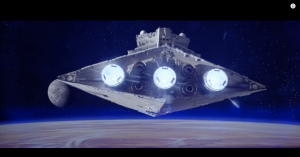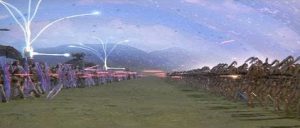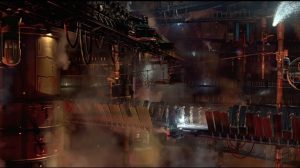Anti-modernization Views in the Star Wars Narrative
Through the years, George Lucas’ Star Wars franchise has begotten an expanded universe abundant in symbolic and metaphoric nuances that help to both lead and enrich each story. While Star Wars follows a fictional narrative, its complexities lend themselves to interpretations, criticisms, and cautionary examples of historical and contemporary elements of the real world. Elements within the Star Wars narrative have clear parallels to historical classism and wartime disharmonies such as fears of nuclearization during the latter half of the 20th century, the controversiality of the Vietnam war, Nazi German nationalism—which are all reactions to structural reorganization of the social and economic standards of first world societies following the industrial revolution. When we step back further, we can begin to see that the stimuli for many of Star Wars’ narrative elements are rooted in much broader terms: a fear of social change from older, more traditional values. Rather than a direct reaction to any particular happenings of the 20th century, Star Wars warns us against the impacts of the social reincarnation under industrialization and modernization in its entirety through its symbolic use of characters, themes, and stories geared towards a pro-traditional mindset.
These themes of anti-modernization make themselves most apparent when we contextualize the Jedi in comparison to the Empire. It appears plainly that the Jedi Knight is the ultimate symbol of good (in regards to the perspective in which Star Wars is presented to the viewer), narratively heroic. The Jedi are a paradigm for peace and order in the Star Wars Universe and help the viewer to gauge the distinctions between the light and the dark. The Jedi are depicted as powerful, strong-willed, and are generally the protagonists of the story. But the aspects of a Jedi that make them compelling extend further than this. These protectors of justice are arguably the most apparent symbols of traditional values in the entire Star Wars Franchise.
The Jedi Knight in its most basic form is a spiritual figure. The Jedi believe in an ancient set of values and traditions from which they derive their strength. For a Jedi, all authority comes from the connection with The Force, a symbol, which in itself, is anti-industry. The Force is said to flow through all living things, the most powerful link to the natural world. The closer this spiritual relationship to nature, the more powerful the Jedi becomes. For the Empire (the “bad guys”), however, this relationship is completely antithetical. The Empire is made powerful by the devices of man. They rely directly on technological advancement, science, and military conquest to assert their dominance. Our first introduction to the Imperial forces asserts this view immediately. In A New Hope, we are introduced to the colorless, angular, man made hull of a Star Destroyer before ever seeing an Imperial soldier in the flesh, as it fires upon a friendly vessel.

It is a metaphorical representation of everything the Empire stands for—preeminence over the natural world through a mechanical crusade. This notion is intentionally imprinted on the viewer immediately after the opening credits roll, established in our very first glimpse of the film so that we maintain this association—that machinery is the design of evil—across the trilogy.
Notwithstanding, the existence of a malevolent “dark side” of the force initially seems to contradict this overarching view, since it affirms a connection between nature and evil. However, the relationship The Force has with the light and the dark is asymmetric. The paths to both sides of The Force are governed by unique subsets of emotion and mental equanimity, some of which can be directly linked to popular sentiments toward historical events of modernization. The industrial revolution brought the United States new ways to manufacture—motorized, automated, faster, and cheaper. As goods were able to be produced at a larger scale than ever before, the U.S. had a drastic financial shift to a market economy, slave to the variability of supply and demand and sparking the rise of big business. Socially, this set an American agenda for consumption. Material wealth became a growing sign of status more than ever before. Nonetheless, radical change is never without backlash. Overtime, the 1% began to be socially denounced by a new generation of counterculture that aligned themselves with a far-left political ideology, particularly into the 1960s (a time during which Lucas himself was coming out of his youth). Corrupted by capitalist desires, those that ran the industrial economy became a symbol for avarice and indulgence (the capitalist pig). Could this counterculture ideology have had an impact on George Lucas? Star Wars, at least, seems to reflect this notion. In parallel, these perceptions—those of greed, jealousy, and lust for material things—are what lead a Jedi to the dark side of The Force. In Star Wars: The Revenge of the Sith, the forever mercurial Jedi apprentice, Anakin Skywalker, confronts Jedi Master Yoda about his visions of pain and loss—constant nightmares that haunt his thoughts. These mirages present Anakin with the supposition that his near future will strip him of the things he holds most dear. Seeking guidance, Anakin is receipted with warning. Yoda advises him against strong attachments to material objects and physical beings, understanding the dangers caused by desires over tangible things. He advises Anakin: “The fear of loss is a path to the Dark Side…attachments lead to jealousy, the shadow of greed, that is”. But instead of heeding these words, Anakin lets his fears and jealousy overcome him and he is ultimately lured into the dark.
Aside from the spiritual principles of a Jedi, there are numerous other details that assert their positions as symbols of tradition. Take, for one, the attire of the Jedi. The Jedi garb consists of full-bodied robes of various shades of brown and black that hold many physical resemblances to the attire of >14th century Monks.


This seems to apply a deeper monastic inspiration for the Jedi Knight. The school of the Jedi religion requires the strict practice of celibacy and demanding emotional restraint, forswearing wordly bonds, in order to form a greater connection with their spiritual roots. These demands draw strong congruity to the practice of asceticism fashioned by the Buddha and carried on by many monastics for centuries to come.
However, the genius of the Star Wars wardrobe manifests when the forces of good and evil come in contact. Only then, are the symbolic undertones fully accentuated. When compared to the attire of the Imperial troops—clad in a contemporary, Nazi-esque war uniform1—the garments of a Jedi feel remarkably dated and remarkably out of place. Apparel becomes a visual reminder of which side the characters are fighting on: the earthy tones of Jedi robes remind us of dirt, wood, soil, sand, and the gray and jet-black of the Empire remind us of the color pallette of industry—the primary reds and blues of Imperial officer’s badges resembling nothing more than color-coded wiring in a larger machine-like dress code.
Beyond monkhood, the medieval significance of the Jedi Knight is further reaching. The use of the word “Knight” in itself harkens back to the bygone warriors of a long past age. Even the weapon of a Jedi, the Lightsaber, while technologically futuristic, sources its power from kyber crystals, a natural material. Unlike the blasters used by Empirical troops which resemble modern artillery, the lightsaber parallels the sword, a traditional and antiquated weapon. In every sense, the Jedi represent an old way of living while the Empire pageants the treachery of modernization.
Additionally, visual nods to the villainous qualities of industrialization become even more metaphorically significant when analyzing the Sith and other high ranking evil. The Prequel Trilogy shows young Anakin Skywalker walking a fine line between the light and the dark. His emotions and desires, those of impatience, romantic attachment, and hunger for power and respect, pull him ever closer to the Dark Side. Yet, even through his wavering temptations, Anakin is never constant in his strain toward evil. We, the viewers, as well as the story’s other characters, can still manage to see the good in him. He is, in one way or another, redeemable. Only in the finale of Revenge of the Sith, after Anakin is defeated by his master, Obi-Wan Kenobi, dismembered and left to burn to death, do we see a permanent change to the Dark Side. Grasping to the little life he has left, he is no longer Anakin Skywalker but Darth Vadar. He is no longer man but machine. He is at last devoid of hope and forsaken by the Jedi. Marked only by the loss of his autonomously organic body, enslaved to a monstrous mechanical shell, does he truly lose all of his redemptive qualities, devoting himself to the ways of the Sith and, thereby, the Dark Side of The Force.
This distinction is furthered when we look at Anakin’s puppeteer, Sheev Palpatine. Deceitful and persuasive, Palpatine plays off of Anakin’s emotions in the Prequel Trilogy to fuel a bitterness against the Jedi. Once Anakin is ensnared under the thumb of corruption, Palpatine finally divulges himself to Anakin as the Dark Lord of the Sith and the soon-to-be leader of the entire Galactic Empire. But visually, we discover that Palpatine’s transformation into the disfigured form now iconic to the hooded Emperor is due to a show of his own unique force abilities. As a Sith lord, Palpatine has mastered the skill of force lightning, able to inflict energetic bolts of electricity upon his enemies from the point of his fingertips. After a pivotal duel in Revenge of the Sith, Jedi Master Mace Windu deflects Palpatine’s force lightning with his lightsaber, reversing the damage back onto Palpatine, which physically mutilates his facial features into a more horrifying, outwardly revolting appearance. Not only does the individual in control of the entire Empire’s function have a direct connection to the power source that facilitates technological device’s function, but it is also the very thing that, like Anakin, makes him more outwardly villainous. It is more than fitting that the source of evil is, in himself, a source of electrical energy.
Besides this, the Prequel Trilogy, particularly Star Wars: The Phantom Menace and Attack of the Clones gives us a sneak peek into the symbolism of industrialization’s impact on creation in the Star Wars universe—mass-production being the blight of natural birth. At the outset of the Prequels, the Confederacy of Independent Systems begins constructing a Separatist Droid Army in secret. This army comprises of various models of single-function and physically identical robotic units programmed to follow orders for destruction. Throughout the movie, these militarized Droids hinder the human protagonists with gunfire, complicating their triumph over the forces that seek to dominate them. Yet the metaphorical significance of the Droid army does not fully contextualize until the climactic conflict of the movie—the Battle of Naboo. In this battle, the armies of good and evil are pitted against each other, distinctly different not just in motivations alone, but also in visualization. As the Trade Federation invades Naboo with the strength of the Droid Army, our protagonists, aided by a militia of Gungans (an indigenous species of Naboo with generations of culture and tradition on the planet), fight the fist of industrial creation. It is organic life vs industrial creation, as the reptilian-looking Gungans seek to preserve their natural home, driving away the foreign, machine-like Droids that intend to take control of their planet.

Star Wars: Attack of the Clones furthers this connection between industry and evil even more plainly. In the movie, the viewer is granted a first-hand look into the creation of Droid soldiers. During an attempted rescue of Obi-Wan, Anakin, Padme, C-3PO and R2-D2 find themselves inside of a Geonosian droid factory. As they struggle to escape, we witness large-scale production remarkably akin to that under the industrial revolution. Through plumery billows of smoke and the cacophony of pistons, drills, steam and solder, is row after row of assembly line, quite literally manufacturing the opposition. Here, factory production is precisely the source of evil.

On top of this, even the oppositional military forces that are biologically living still have roots in mass-production. Preceding the dawn of the Clone Wars, the Republic Military began a project to create a republic army consisting of genetically identical soldiers manufactured for the sole purpose of killing. The clones, like the droids, are akin to industrial assembly line product, large-scale manufactured and symbolically homogenous, identical and expendable to their overseers (perhaps commentary on how soldiers are viewed in modern military). They are both the same in their all-white armor as they are within those suits. While initially possessed by the Jedi, this clone army eventually falls into the hands of the Dark Lord of the Sith and ultimately becomes the undoing of the Jedi and initiates the Clone Wars. Just as in the real world with the Great War, industrial achievement similarly brought about war within Star Wars.
Nevertheless, it isn’t just the forces of evil that utilize mechanical, robotic forces. We must now recognize that the heroes too are accompanied by droid companions. However, they are narratively treated wholly different from the droids of the Empire. These good droids, rather than militarized machines, are displayed essentially as intelligent biotic creatures. Even those without voices (take R2-D2 and BB-8 for example) are written with lively personalities, coercing the audience into viewing them with equal existent worth as the human characters. They break their coded demarcations—thinking independently, being socially aware, expressing unique friendships, charm and humor, feeling pain, joy, sadness, remorse, disdain and respect. In some respects, their personalities outshine many of the living characters. If not particularly humanoid, these good droids are designed to look cute, more reminiscent of a lovable pet than a machine. In doing this, the narrative steers our perceptions in every other direction besides seeing them for what they are: mechanical tools, a tactic that is not clearly demonstrated with the droids of the Empire.
Moreover, the distinct settings within the Star Wars universe further solidify this narrative of tradition vs modernization. Planets that are presented to us as peaceful and beautiful are hallmarks of tradition. Take Alderaan for example, the home of our female protagonist, Leia. Alderaan is a culture-rich civilisation with thousands of years of history in nature, philosophy, and the arts. It’s blue-green geography pays homage to our own planet in its natural state. It’s abundant history also comes with political ties, being known as one of the oldest members of the Galactic Republic. Its extensive past brings it sophistication, knowledge, organization, and power, until its obliteration at the hands of the Empire, whose homes are temporary and industrial—man-built and weaponized—with a history of destruction rather than growth. And whenever nearly in the grasp of evil, the Jedi seek the natural world for safety. Dagobah conceals Yoda from the menace of order 66 and Ahch-To shielded the exiled Luke Skywalker from the First Order. Like a mother’s arms, Star Wars shows how nature can be a haven—a reminder of a simpler peace and comfort.
On the whole, if we follow the narrative close enough, modernization in Star Wars fathers an oppression of the natural world. While teaching us lessons of the past, Star Wars also hypothesizes on our social, economic, and environmental impacts on the future. Nature is not always tranquil in the Star Wars Universe. It is full of dangerous biomes and even more dangerous creatures. But perhaps this is meant to show us that nature, if agitated, will fight back. Similar to how the industrial engine of the Empire destroys Alderaan, our own post-industrial marketplace economies are destroying our own planet. With factory pollutants and plastic wastes from consumable products being large contributors to the global concern over the destruction of nature and rising CO2 emissions, how can we put ourselves in the shoes of the Empire to see our impacts on the natural world before it is too late? The pejorative nature of Star Wars towards modernization, could, in many ways, be an attempt to use its widespread popularity as a way to vilify our current social behaviors and open our eyes, through metaphorical stories, to what is analogous in the real-world.
1Compare to the German Uhlan: high-buttoned coats, flared Jodhpur pants, high cut boots.
Work Cited
Agostini, De, and Biblioteca Ambrosiana. “Fourteenth-Century Franciscan Monk with a
Cassock and Crucifix,…” Getty Images, www.gettyimages.co.uk/detail/illustration/fourteenth-century-franciscan-monk-with-a-cassock-and-stock-graphic/664672575.
Lucas, George, and George Lucas. Star Wars I: The Phantom Menace .
Lucas, George, director. Star Wars IV: a New Hope. Lucas Film Ltd, 1977.
Lucas, George, director. Star Wars: Episode II: Attack of the Clones. 20th Century Fox Film
Lucas, George, et al. Star Wars, Episode III, Revenge of the Sith. 20th Century Fox, 2005.
Corp., 2002.
Star Wars: from a Certain Point of View. Century, 2017.
“The Industrial Revolution and the Changing Face of Britain.” British Museum – The Industrial Revolution and the Changing Face of Britain Page 3, research.britishmuseum.org/research/publications/online_research_catalogues
An article about the effects the industrial revolution had on society in Britain. Talks about how, while it made many people very rich, it left the working class with very little, creating a societal divide that fueled resentment.
“Wookieepedia.” Wookieepedia | FANDOM Powered by Wikia,
starwars.fandom.com/wiki/Main_Page.
Helpful tool for research on specific topics and characters within the official Star Wars canon. Here, I could find background details and refresh my memory on certain topics that helped me to build my argument.

Bova’s paper eloquently explores the ways in which Star Wars speaks out against technological modernization, instead idolizing the natural world as an ideal state of being. He contrasts the Empire with the Jedi, analyzing the ways in which the Empire represents the evils of technological advancement, while the Jedi serve as an argument for living a life connected to nature.
I would take a counter stance to his argument by bringing to light one of the logical flaws integral to his paper. Bova contrasts the Jedi Order and the Galactic Empire as if they are opposing forces, inverse ends of the spectrum of power. However, the Jedi Order is not directly in contrast to the Empire – it lies instead in opposition to the Sith. The more accurate oppositional force to contrast with the Empire would be the Rebellion, rather than the Jedi Order. It is true that these two pairs of entities (Jedi and Rebellion, Sith and Empire) are linked, but due to idealistic differences and foundational goals, they should be treated separately.
It is interesting, therefore, how the Jedi have chosen to ally with the Rebellion/Resistance, and the Sith have chosen to ally with the Empire/First Order. It would seem to me as if these two sets of opposing entities would remain separate from one another, simply due to the nature of the force and its supposed asceticism.
I would thus ask Bova to analyze what happens when we take into consideration the technical prowess of the Rebellion in contrast to that of the Empire. Their technology is often less mechanically advanced than that of the Empire, but they do not refrain from using it to accomplish their goals. Additionally, Episode IIX: The Last Jedi underscores the similarities between technology use in the First Order and the Resistance through revealing the manner in which they purchase weapons from the same corrupt suppliers. This implies the two have a similar relationship to the use of military technology, and should be judged accordingly as equals.
I am fascinated by the link Bova draws between Palpatine’s force lightning power and the mechanical prowess of the Galactic Empire. It cannot be a coincidence that the Empire is powerful in the realm of technological advancement while their Sith leader uses electricity as a weapon. It rhymes far too well to be unintentional. Bova makes an interesting claim about the links between the Sith and the Empire, though I still question whether the Empire’s direct oppositional force is the Jedi Order.
Though I disagree with the manner in which Bova contrasts good and evil in Star Wars, his claim that Star Wars is an argumentative text in favor of a return to nature is excellent. The parallels he draws between technology and evil are effective, as are the ones between nature and good. Cameron Culwell’s paper also places Star Wars into an argumentative context, with a thesis which argues the intent of Star Wars, specifically the sequel trilogy, is to comment upon the rise of a younger generation in place of an ineffective older one. These two papers draw upon the narrative as a whole to search for deeper themes and meanings in the arc of the films. Both draw fascinating conclusions, which are not mutually exclusive.
Another element of Bova’s paper I appreciate is his subversion of socially acceptable patterns of thought. Bova’s paper treats the concept of technology in the same manner in which the Gothic genre treats gender. The “…Gothic text…resonates exactly with the impulse in gender studies to deconstruct the social ‘givens’ of masculinity and femininity (Horner and Zlosnik, 56). Bova’s paper, too, contradicts accepted ideas by arguing that technological advancement is not inherently good for society. He does this by showing how the Empire uses technological advancement for sinister purposes. In this way, Bova demonstrates how Star Wars is able to subtly subvert the norms of our society for the purpose of provoking viewer engagement.
His argument is strong and well-organized, and his paper contextualizes the story of Star Wars in an entertaining and socially applicable way.